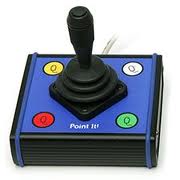The Mouse and other Pointing Devices

Background
Although possibly not the first computer pointing device (this honour goes to the trackball) by far the most common pointing device used with computers is the mouse. The mouse was first introduced by its inventor Douglas Engelbart as the 'X-Y Position Indicator for a Display System' in San Francisco in 1968. In the 70's and early 80's a couple of computer manufacturers included mouse devices with their systems but it wasn't until 1983 and its inclusion by Apple as standard equipment that it was really popularised. This happened in tandem with the increased use of Graphical User Interfaces (GUI) and the birth of the 'desktop' metaphor. Today there are many alternative pointing devices available to computer users but they all follow the same principles, movement of the pointing device is reflected in movement or the cursor on screen. Most pointing devices also use a button to select chosen icons on the screen. Sometimes however a button is not available or the user has difficulty activating a button. In this case a technique called 'Dwell' can be employed with the aid of a software application. Dwell allows an icon to be selected by merely hovering over it for more than a predetermined length of time. The majority of computer users use a pointing device of some kind as the predominant means of interacting with a computer.
Return to topVideo
Double click on video to see in full screen.
-
Types of pointing device
The Mouse and other types of Pointing Device
Above is a video demonstraiting various mouse alternatives. Below are photographs of various different pointing devices. Click each photograph for more details on that device.
Return to top
Low Cost Options
The Mouse and Trackpad are mainstream devices and therefore there are a wide variety available on the market for what would be considered in Assistive Technology terms as low cost. With the increase in workplace injuries related to repetitive strain companies like Logitech and Kensington now also offer a wide range of trackballs that are often a fraction of the cost of those offered by Assistive Technology manufacturers and may serve the purpose just as well. The list below is more concerned with the high end Assistive Technology pointing devices.
- JoyToKey enables PC gaming Joysticks to mimic a mouse and the keyboard. It is a freeware utility which can be of great use to disabled users. Gaming Joysticks cost significantly less then those sold as Assistive Technology and in many cases will work just as well. Although this software is not for everyone (it is not particularly user friendly) it has the ability customise a gaming joystick into a highly efficient computer access method.
- Dwell Click: Dwelling is resting the mouse over one area of the screen for a specified time. The dwell click software allows you to perform left-click, right-click and double clicks, and even drag things around the screen.
 Mouse
Mouse Trackball
Trackball Joystick
Joystick Touchpad
Touchpad